Current Beach Updates & Conditions
Learn more about current beach conditions in St. Pete/Clearwater, home to America's Best Beaches.

Honeymoon and Caladesi islands are state parks that are beloved for their stunning beaches.
Updated April 21, 2024
Our award-winning beaches are the jewel of the St. Pete/Clearwater destination! Learn more about America's Best Beaches before your visit.
Over the summer in 2023, our area experienced storm surge from Hurricane Idalia. As a result, Pinellas County conducted a series of small shoreline restoration projects, constructing dunes to mitigate erosion. We're happy to report that these dune restoration projects have been completed, and all public beaches are open.
To help protect our beaches, it's very important that you avoid walking on dunes and any areas with sea oats or other vegetation. Please use designated boardwalks and pathways to access the beach. Learn more about the dune and beach restoration project.
At this time, there is no red tide at St. Pete/Clearwater's beaches.
Travel + Leisure has named Clearwater Beach one of the 15 Best White-Sand Beaches in the World!
See For Yourself
Take a look at this live beach webcam to see what's happening on America's Best Beaches. And check out our live webcam page for even more views of our beaches.

St. Pete Beach at TradeWinds Island Grand Resort
Take a look at the gorgeous waters and soft white sand lining the coast at one of St. Pete/Clearwater's top resorts.
Read More About St. Pete BeachLive Webcam (no audio)
Join a Clean-Up!
Participate in a beach or park clean-up to help keep our sands, parks and waters clean and beautiful. You're likely to meet some new friends along the way! Check out even more info on how you can help at "Keep Pinellas Beautiful."
Keep Pinellas BeautifulBeach Safety and Courtesy Every Day
On any beach day, it's important to be aware of current beach conditions. Look to the beach flag warning system (see details lower on this page) and heed any posted warnings. Rip tides are infrequent, but can be present without being obvious to beachgoers.
Below, you'll also find information on seasonal air and water temperatures, as well as additional resources to help you plan your beach vacation.
As you enjoy America's Best Beaches, please remember to be considerate of other beachgoers, wear sunscreen, stay hydrated, and have a safe and sunny beach day.
Florida's Beach Warning Flag Program
Many Florida beaches, including beaches in St. Pete/Clearwater, utilize a beach warning flag system to let beachgoers know of current beach conditions. You'll most often see beach warning flags posted on or near lifeguard stands.
Here are the beach warning flag colors and what they mean:
Green Flag: Low hazard, calm conditions.
Yellow Flag: Medium hazard with moderate surf or currents.
Red Flag: High hazard, with high surf or strong currents; when these conditions are present, lifeguards may ask swimmers to get out of the water.
Double Red Flag: Water is closed to the public (you may still walk on the beach, but you may not enter the water).
Blue Flag: Stinging or hazardous marine life such as stingrays or jellyfish are present.
It's important to note that rip currents can occur unexpectedly at any beach. Swimmers should be aware of their surroundings and read about what to do if they get caught in a rip current.

The Best Travel Ideas, Straight to Your Inbox!
Sign Up for Our eNewsletter Now!What's Trending
What's Trending
Average Water Temperatures
| January | 64 F | 17.7 C |
| February | 64.4 F | 18 C |
| March | 66.7 F | 19.3 C |
| April | 73 F | 22.8 C |
| May | 78 F | 25.6 C |
| June | 82.4 F | 28 C |
| July | 85 F | 29.6 C |
| August | 86.7 F | 30.4 C |
| September | 84.6 F | 29.2 C |
| October | 81 F | 27.3 C |
| November | 75 F | 23.8 C |
| December | 68.5 F | 20.3 C |
Average Air Temperatures
| Month | High | Low |
| January | 66.7 F /19.3 C | 57 F / 13.7 C |
| February | 68.7 F / 20.4 C | 59 F / 15 C |
| March | 72 F / 22.3 C | 62 F / 16.7 C |
| April | 78 F / 25.4 C | 68 F / 20 C |
| May | 82 F / 27.9 C | 78 F / 25.6 C |
| June | 86 F / 29.9 C | 78.4 F / 25.8 C |
| July | 87 F / 30.7 C | 80 F / 26.6 C |
| August | 88 F / 31 C | 81 F / 27 C |
| September | 87 F / 30.3 C | 78 F / 25.5 C |
| October | 81 F / 27.3 C | 73 F / 22.5 C |
| November | 81 F / 27.3 C | 75 F / 23.9 C |
| December | 71 F / 21.5 C | 61 F / 16.2 C |

